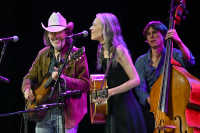George Rowlett’s new paintings have wonderfully tousled, wind-rucked surfaces, the paint stirred and whipped up in moving emulation of the effects of the elements on water and landscape — his principal subjects. He paints the Thames and the seashore of east Kent; he also records the passage of the seasons on the landscape around Deal where he has a studio. In his latest solo exhibition, the groundfloor gallery of Art Space is dominated by a large and splendid painting called ‘Ramsgate from the Tidal Flats, Pegwell Bay, January’. The pigment is heaped on with spatulas and fingers (Rowlett has given up using brushes) in great joyous horizontal swathes of pink, grey, mauve-blue and lilac above a rusty-russet ground, liberally overlaid with dribbles and trails and flicks of paint, which bear witness to the excitement of its application. Every inch of the painted surface is activated, alive with light and rapturous in celebration of natural beauty.
Downstairs, painting after painting holds the wall with superb authority. Look at the broad luscious strokes which make up ‘Rape to Ripple Church, Weather Changing’: the flowering rapeseed is literally a knockout. The predominantly green and blue ‘Across East Wear Bay to the Warren, Folkestone’ is succinctly fired up by a passage of red and yellow at bottom right. A view of Margate is more contemplative, another towards Ramsgate is all surging pink cloud. A large painting of snow is full of daring colour. Rowlett is inventive and assured, breaking new ground in subject matter (a couple of paintings of a dead thrush have been added to his poignant still-life repertoire of animal skulls) as well as in paint-handling.
The titles are descriptive and lengthy. For instance: ‘Winter, Low Tide at Greenwich, Pontoon, Dolphin and Cormorants from Primrose Wharf’. You could get more precise than that, but it wouldn’t fit in the catalogue. The titling helps to focus the way the viewer looks and deciphers — drawing attention to the cormorants on the right of the picture, sitting on a wooden pile, for instance — though I’d say the powerful surface movement in this rich, dark picture owes something to the Finnish painter Akseli Gallen-Kallela’s masterpiece in the National Gallery, ‘Lake Keitele’. I’m glad that Rowlett tells us that his maelstrom painting ‘Westminster Bridge, Bubbling Clouds’ contains ‘Thoughts of Hiroshige’, it makes it slightly easier to attune to its wildness.
This exhibition marks another move forward by an already impressive artist: Rowlett just gets better and better. For the quality of the work, his prices are remarkably competitive, and he deserves all the success he is currently achieving.
Over in the West End, Robert Dukes (born 1965) is enjoying similar good fortune at Browse & Darby. A pupil of Euan Uglow, Dukes has demonstrated in various group shows (The Discerning Eye and the RA Summer Exhibition, mainly) that he has forged an independent vision of considerable skill and sensitivity. This is overwhelmingly confirmed by his first solo exhibition, beautifully hung by the artist himself and very nearly a sell-out.
Dukes is essentially a still-life painter, his approach rooted in close observation under controlled conditions. His biggest problems are with movement in space, and making forms legible. The way twigs or fruit move through real space somehow has to be translated into a convincing two-dimensional existence on the picture plane. Quince, squash, the quarters of an apple or wild rosehips in turn become the focus of the artist’s scrutiny and urge to pictorial problem-solving. What is remarkable about his paintings is that they look so full of life and vigour even though subjected to such strict procedural disciplines.
One of the factors which doubtless contributes to this vivacity is Dukes’s appreciation of other art. His openness of response extends from Veronese to Craigie Aitchison, via Georges Braque. There are half-a-dozen paintings in the show which are reinterpretations of Braque, and which salutarily offer him a very different model to the measured cadences of Uglow. Some of the finest pictures here are of pears, one of which Dukes painted after seeing the Aitchison retrospective at the Academy in 2003, which influenced his use of colour. (Note the band of blue beneath the table-top, and the rich purply-plum tones of the background.) The drawings in the downstairs gallery pay homage to a variety of masters, from Goya to Balthus, by way of Courbet and Bonnard.
What’s an exchange of skulls between friends? George Rowlett has been painting a roe deer skull that Robert Dukes obtained for him; in this show we see the same skull as depicted in much thinner paint, in altogether quieter fashion, by Dukes himself. These two painters share an intense celebration of things seen that does much to rehabilitate the concept of beauty in contemporary art.
Ivon Hitchens (1893–1979), one of the giants of British modernism who developed a robustly lyrical interpretation of the Romantic landscape tradition, and made it new, is less known for his nudes. These are at present brilliantly showcased by Jonathan Clark (who handles the Hitchens estate) in an exhibition of museum quality, previously shown at the Towner Art Gallery in Eastbourne. Anyone at all interested in 20th-century British art should hurry to this exhibition, for there are a number of very fine things on display — both drawings and paintings — and one especially gorgeous nude in an interior called ‘Juno’ (and just as statuesque). This painting hasn’t been publicly exhibited since the 1930s, and has now been sold to a private collector in America, so will shortly be departing these shores. I urge you to see it before it goes.
Another artist who was early influenced by Braque, Hitchens shared a typically joyous French attitude to light and colour, to capturing the essence of things, that can be seen in the wiry and expressive line drawings that will surprise those viewers familiar only with his painterly landscapes. If the names of Matisse and Bonnard are here invoked, there’s no shame in that, but the lovely leaping line of the figures in his study for the murals at Cecil Sharp House has an intensely musical quality which is rare in any art. Hitchens drew all the time, but it was largely a private domestic occupation, not made for exhibition. A massive full-scale monochrome cartoon for a proposed mural, entitled ‘Restday Figures in Landscape’, is the public face of this activity, and looks inordinately impressive hanging opposite ‘Juno’. The particular combination of kissing profiles within a taut rhythmical framework of figures and landscape is highly effective. Among other delectable works on show are ‘Nude – Pink & Blue’, a late but highly sensuous oil, daring in its abbreviated form and radical simplification, and the glowing ‘Figure – Variations on a Theme No. 9’. A vivid and unforgettable experience, making up a trio of outstanding shows.





Comments